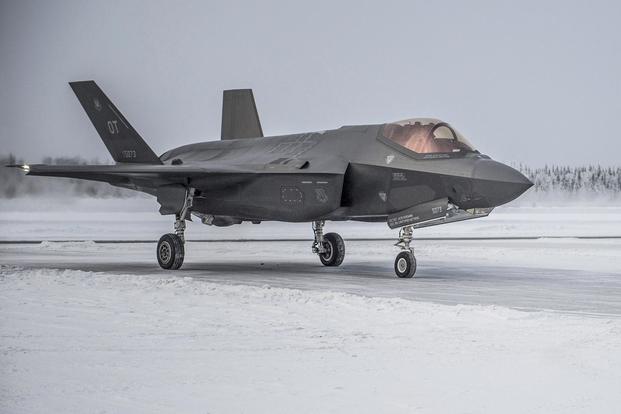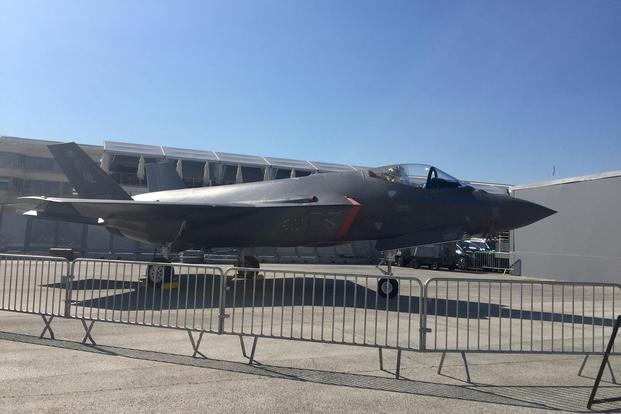SALON DU BOURGET, PARIS -- More than 400 F-35 Joint Strike Fighters are operating from 17 bases worldwide. From the near-Arctic region of Ørland, Norway, to a recent deployment in the Middle East, the fifth-generation jet is expanding its reach.
But a recent news report shows that weather conditions have some effect on the Pentagon's stealthy fifth-gen fighter, raising concerns about its performance in extreme climate locations.
In a recent Defense News report series, the outlet obtained documents showing that cold weather triggered a battery sensor in an F-35 Lightning II in Alaska. While the battery was not affected, the weather "overwhelm[ed] the battery heater blanket" that protects it, prompting the sensor to issue a warning and causing the pilot to abort his mission and land immediately, Defense News said.
"We have already developed an update to the software and the battery's heater control system to resolve this issue, and this updated software is available for users today to load on their aircraft in the event they will be conducting extreme cold weather operations," Greg Ulmer, vice president of Lockheed's F-35 aircraft production business, said in an interview with Military.com at the Paris Air Show, adding the update will be in new planes by 2021.
Related content:
- Air Force Sees Unique Challenges in Deploying Stealth Fighters
- Turkey Unveils its Own TF-X Next-Gen Fighter Amid F-35 Uncertainty
- General: Older Fighters Can't Match F-35
The U.S. military anticipated taking the Lockheed Martin-made F-35 around the world, with partners and allies flying the plane in both hot and cold regions, including some that are changing.
"The [F-22 Raptor] and plenty of other aircraft have flown out [to Alaska] just fine for decades," Rebecca Grant of IRIS Independent Research told Defense News. Grant is a former director of the Mitchell Institute for Airpower Studies at the Air Force Association. "The F-35 should have had all that sorted out in the climatic lab."
Ulmer, however, said all necessary steps were taken in lab testing, and the issue identified was a normal part of the design and development process.
"You do the best you can relative to the engineering, understanding of the environment, to design the part. And then you actually perform, and [you realize] your model was off a little bit, so you have to tweak the design … to account for it," Ulmer said. An F-35A from Hill Air Force Base, Utah, was on static display here during the show.
"We're confident in the F-35s performance in all weather conditions," he said.
The battery issue was first discovered during extreme cold weather testing at -30 degrees and below at Eielson Air Force Base, Alaska, in February 2018, he added.
Ulmer explained there are various tests points done before the plane heads to the McKinley Lab at Eglin Air Force Base, Florida, for robust experiments. The lab is responsible for high-range weather testing of military and commercial aircraft, munitions and weapons.
The lab's refrigeration chamber can go as low as -70 degrees, lab chief Dwayne Bell told Military.com during a visit to the facility in 2017. He said at the time that the F-35 program had been one of the most expensive programs tested in the lab to date. There's a wide range of testing costs, but they average roughly $25,000 a day, he said.
It cost about $7 million to test the Marine Corps' B-model from the Patuxent River Integrated Test Force, Maryland, over a six-month period, Bell said.
The Lightning II was put through major weather testing -- the lab can do everything but lightning strikes and tornadoes -- such as wind, solar radiation, fog, humidity, rain intrusion/ingestion, freezing rain, icing cloud, icing build-up, vortex icing and snow. It handled temperatures ranging from 120 degrees Fahrenheit to -40 degrees, officials said in 2017.
But even testing at McKinley is limiting, Ulmer said.
"What doesn't happen is that they don't stay there a long time, so once we released [Block] 3F [software] capability, now the operational fleet can actually" test new extremes, he said, referring to both speed and temperature changes.
Defense News also found that supersonic speeds caused "bubbling and blistering" on the JSF's low-observable stealth coating, and that hot environments impeded sufficient engine thrust to vertically land the Marine variant.
"So they take it" to new environments "and they expose it more than flight test exposed the airplane. I'm an old flight test guy. You expect to learn in the operational environment more than you do in the [developmental test] environment because you don't necessarily fly the airplane [in that environment] all the time," Ulmer said.
"So we learned a little bit, and you refine the design, and you solve it," he said, adding that the design and maintenance tweaks are ongoing. "The probability of the issue reoccuring on aircraft in the operational fleet is very low and with minimal impact to safety of flight or operational performance."
Thirteen Category 1 deficiencies were found and reported by operators, according to the for-official-use-only documents Defense News obtained. Cat 1 is a label for problems that would directly impact safety or the mission. Those ranged from coating fixes; pressure anomalies in the cockpit that gave pilots ear and sinus pain; and washed-out imagery in the helmet-mounted display, among others.
The Air Force, Navy and Marine Corps each fly a variant of the aircraft designed for different scenarios, from landing on conventional runways on land, to catching arresting cables on aircraft carriers, to landing like a helicopter on amphibious assault ships.
Responding to the Defense News article series, Lockheed Martin said each deficiency "is well understood, already resolved or on a near-term path to resolution."
"We've worked collaboratively with our customers, and we are fully confident in the F-35's performance and the solutions in place to address each of the items identified," the company said in a statement June 12.
Growing pains with new planes and weapons programs are common. But the F-35 program has been under scrutiny since its inception, mainly for cost-effectiveness and functionality. A new estimate suggests that operating and supporting fighters for the next 60-plus years will cost the government $1.196 trillion.
The older F-22 Raptor has had similar issues, especially with its stealth coating, which officials have said is more cumbersome to fix than the F-35, which was built with a more functional and durable coating in mind.
"The [low-observable] system has significantly improved on the F-35 when compared to the F-22," Ulmer said Tuesday. "That's all lessons learned from F-22, applied to F-35."
-- Oriana Pawlyk can be reached at oriana.pawlyk@military.com. Follow her on Twitter at @Oriana0214.












